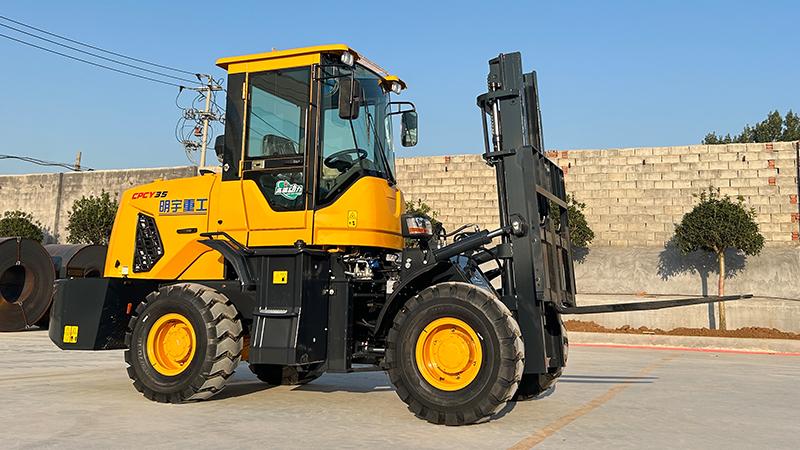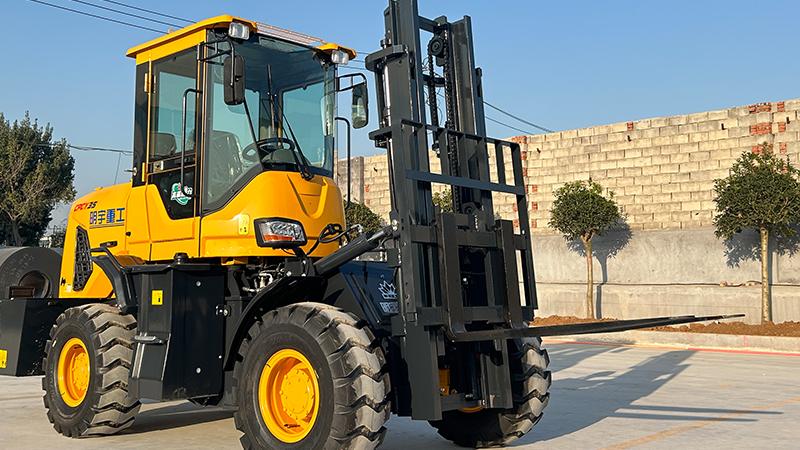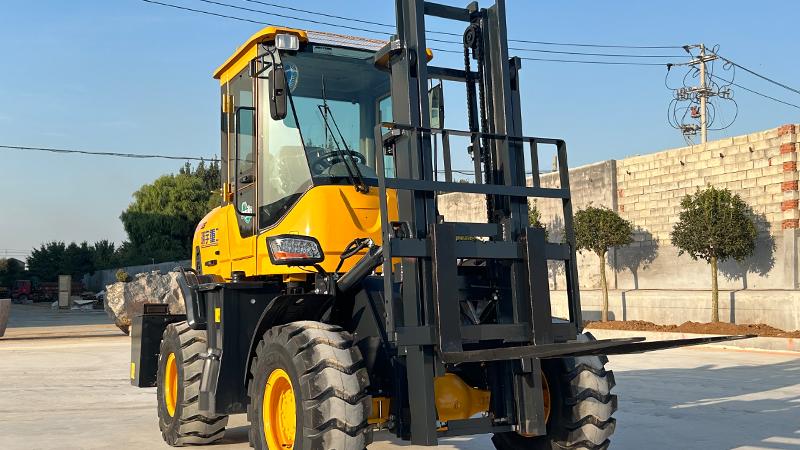In the realm of heavy industry, construction, lumber yards, and major infrastructure projects, where the terrain is unforgiving and the loads are colossal, the conventional warehouse forklift is utterly out of its depth. This is the exclusive domain of the off-road forklift, a behemoth of machinery engineered not for polished concrete floors but for mud, gravel, sand, and steep inclines. A question paramount to any project manager, logistics coordinator, or heavy equipment buyer is: "What is the lifting capacity of a heavy-duty off-road forklift?" The answer, far from being a simple number, unfolds as a complex narrative of engineering prowess, specific application requirements, and a delicate balance between power and stability. Understanding this capacity is not just about knowing a statistic; it's about comprehending the very DNA of these rugged machines and how they are tasked with moving the world's heaviest materials in its most challenging environments.To begin to appreciate the lifting capacity, one must first understand what fundamentally distinguishes an off-road forklift from its indoor cousins. The most immediate visual cues are the massive, deeply treaded pneumatic tires, akin to those found on agricultural or construction equipment. These tires are not for traction on smooth surfaces alone; they are designed to float over soft, unstable ground like dirt and sand, distributing the immense weight of the machine and its load to prevent sinking and ensure continuous operation. The chassis is built with a higher ground clearance to navigate obstacles and uneven terrain without the undercarriage suffering damage. Furthermore, many models feature robust four-wheel drive systems and limited-slip differentials to maintain momentum and traction even when one wheel loses grip. The operator's cabin is often reinforced and may include enhanced suspension for operator comfort during long shifts on rough ground. All these features are not optional extras; they are integral to the machine's core function, and they directly influence how much weight it can safely lift. The engineering that allows it to traverse a construction site also dictates the framework within which its lifting capacity is defined.
So, what is the typical range for these titans of industry? The lifting capacity of a heavy-duty off-road forklift is not a single figure but a spectrum, broadly ranging from 6,000 pounds (approximately 2,700 kilograms) on the lower end to a staggering 36,000 pounds (over 16,000 kilograms) and beyond for the most specialized, custom-built monsters. A common and highly versatile workhorse in many industries might fall into the 10,000 to 15,000-pound capacity range (4,500 to 6,800 kg), perfectly suited for handling palletized building materials, large industrial components, or hefty lumber packs. As we ascend into the heavy-duty classification, capacities routinely reach 20,000, 25,000, and 30,000 pounds (9,000 to 13,600 kg). These machines are the backbone of major shipping ports, steel yards, and heavy manufacturing plants, capable of lifting loaded shipping containers, large-diameter pipes, and heavy machinery components. The very top of the range, those forklifts with capacities exceeding 35,000 pounds, are engineered for singular, extreme purposes, often seen in the energy sector moving massive segments of wind turbines or in heavy fabrication facilities.However, stating a maximum capacity like "30,000 lbs" is arguably the beginning of the conversation, not the end. This figure is intrinsically tied to the load center, a critical concept in material handling that is paramount to safe and stable operation. The load center is the horizontal distance from the vertical face of the forks to the center of gravity of the load. Standard calculations for forklifts, including off-road models, are based on a 24-inch (600 mm) load center. This means the advertised maximum capacity is only guaranteed when the load's center of gravity is exactly 24 inches from the fork face. In the real world, loads are rarely so perfectly configured. A longer, heavier object, like a beam or a large crate, will have its center of gravity further out, say at 36 or 48 inches. This increased load center creates significantly more leverage and torque on the forklift's mast and chassis. Consequently, the machine's actual safe lifting capacity is dramatically reduced. A forklift rated for 30,000 lbs at a 24-inch load center might only be able to safely lift 15,000 lbs if the load center extends to 48 inches. Ignoring this relationship is a primary cause of tip-overs, which are among the most dangerous accidents in material handling. Therefore, the true lifting capacity is a variable, constantly adjusted by the operator's assessment of each specific load.
Beyond the load center, a multitude of other factors conspire to determine the safe working capacity of an off-road forklift at any given moment. The condition and inflation of those massive pneumatic tires are crucial; under-inflated tires can compromise stability and increase rolling resistance, subtly affecting the machine's ability to handle its rated load on soft ground. The terrain itself is a massive variable. Lifting a rated capacity on a firm, level, concrete surface is one thing. Attempting the same lift on a soft, muddy slope is an entirely different proposition. The incline of the ground is perhaps the most critical external factor. Operating on any slope, but especially across a slope, drastically reduces stability and, therefore, the safe operating capacity. Manufacturer manuals always stipulate that loads should be carried in the uphill direction on slopes and that capacities must be derated for inclined operation. The attachments mounted on the forklift also play a huge role. A standard pair of forks is what the capacity is rated for. Adding a sideshifter, a rotator, or specialized clamps for handling paper rolls or barrels adds weight and moves the load center forward, both of which eat into the available lifting capacity. A professional operator must always consult the forklift's load chart—a complex graph usually located on a plaque within the cabin—which provides the precise safe capacity based on the load center, lift height, and sometimes even the attachment used.The engineering that enables these immense capacities is a marvel of mechanical and hydraulic design. The heart of the system is a powerful, high-torque diesel engine, almost always turbocharged, that provides the necessary power not only to drive the machine over rough terrain but also to operate the high-capacity hydraulic pump. This pump is responsible for generating the immense fluid pressure that actuates the hydraulic cylinders. The lift cylinder, a single or tandem massive bore cylinder, is what does the heavy lifting, extending to raise the mast and the load. The hydraulic system is designed for raw power and reliability under constant, heavy stress, often featuring advanced filtration systems to keep the fluid clean and prevent catastrophic component failure. The mast itself, the vertical assembly that guides the forks, is constructed from incredibly high-strength steel, often with a triple or quadruple stage design to allow for significant lift heights while maintaining a compact collapsed size for better forward visibility when traveling. The chassis and frame are the foundation of it all, built from welded steel plates and box sections to be immensely rigid, resisting the torsional forces imposed by uneven ground and heavy loads, ensuring that the machine remains stable and that the load is supported safely throughout the lifting and traveling process.
Choosing the correct off-road forklift capacity for a specific application is a calculated decision that goes beyond simply selecting the machine with the highest number. It requires a thorough analysis of the typical and maximum weights of the materials to be handled. It demands an understanding of the load dimensions to calculate the likely load centers. It necessitates a survey of the working environment—is it flat and firm, or soft and sloped? Furthermore, one must consider the required lift height. Interestingly, a forklift's capacity often decreases as the lift height increases. This is because raising a load high in the air raises the combined center of gravity of the machine and the load, making it less stable. The load chart will show a lower maximum capacity at a full 30-foot lift than it will at a 10-foot lift. Ultimately, selecting a forklift with a capacity that matches but also slightly exceeds the regular requirements provides a crucial safety buffer, accounting for unforeseen heavier loads, challenging terrain conditions, and the inevitable use of attachments. It is a decision where overestimating need is a far safer and more cost-effective strategy in the long run than underestimating it, as overloading a forklift is a recipe for mechanical failure, catastrophic accident, and immense financial liability.In conclusion, the lifting capacity of a heavy-duty off-road forklift is a deceptively simple number that represents the culmination of advanced engineering, rigorous testing, and a deep understanding of physics. It is not a static value but a dynamic one, profoundly influenced by the load's characteristics, the machine's configuration, and the environment in which it operates. From the versatile 10,000-pound models to the colossal 35,000-pound giants, these machines are indispensable tools of modern industry. Respecting their rated capacity, understanding the factors that influence it, and operating within these strict boundaries is the absolute key to unlocking their immense potential safely and productively, ensuring that these mechanical titans continue to build and move the world around us without incident.
Post time:Aug.21.2025



